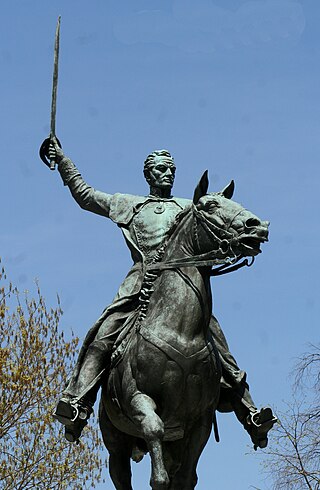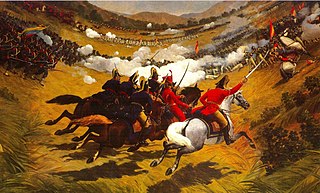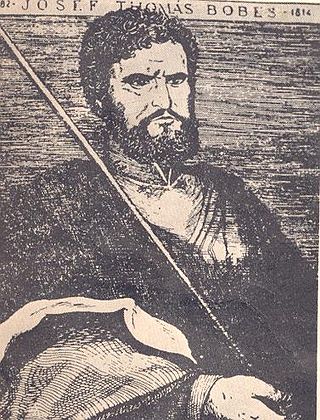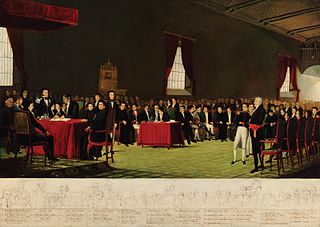
Antonio José de Sucre y Alcalá, known as the "Gran Mariscal de Ayacucho", was a Venezuelan independence leader who served as the president of Peru and as the second president of Bolivia. Sucre was one of Simón Bolívar's closest friends, generals and statesmen.

José Francisco de San Martín y Matorras, known simply as José de San Martín or the Liberator of Argentina, Chile and Peru, was an Argentine general and the primary leader of the southern and central parts of South America's successful struggle for independence from the Spanish Empire who served as the Protector of Peru. Born in Yapeyú, Corrientes, in modern-day Argentina, he left the Viceroyalty of the Río de la Plata at the early age of seven to study in Málaga, Spain.

The Argentine War of Independence was a secessionist civil war fought from 1810 to 1818 by Argentine patriotic forces under Manuel Belgrano, Juan José Castelli and José de San Martín against royalist forces loyal to the Spanish crown. On July 9, 1816, an assembly met in San Miguel de Tucumán, declaring independence with provisions for a national constitution.

The military and political career of Simón Bolívar, which included both formal service in the armies of various revolutionary regimes and actions organized by himself or in collaboration with other exiled patriot leaders during the years from 1811 to 1830, was an important element in the success of the independence wars in South America. Given the unstable political climate during these years, Bolívar and other patriot leaders, such as Santiago Mariño, Manuel Piar, José Francisco Bermúdez and Francisco de Paula Santander often had to go into exile in the Caribbean or nearby areas of Spanish America that at the moment were controlled by those favoring independence, and from there, carry on the struggle. These wars resulted in the creation of several South American states out of the former Spanish colonies, the currently existing Venezuela, Colombia, Ecuador, Peru and Bolivia, and the now defunct Gran Colombia.

The Venezuelan War of Independence was one of the Spanish American wars of independence of the early nineteenth century, when independence movements in Latin America fought against rule by the Spanish Empire, emboldened by Spain's troubles in the Napoleonic Wars.
The Spanish Invasion of New Granada in 1815–1816 was part of the Spanish American wars of independence in South America. Shortly after the Napoleonic Wars ended, Ferdinand VII, recently restored to the throne in Spain, decided to send military forces to retake most of the northern South American colonies, which had established autonomous juntas and independent states. The invaders, with support from loyal colonial troops, completed the reconquest of New Granada by taking Bogotá on May 6, 1816.

Bolívar's campaign to liberate New Granada was part of the Colombian and Venezuelan wars of independence and was one of the many military campaigns fought by Simón Bolívar. Bolívar's victory in New Granada secured the eventual independence of northern South America. It provided Bolívar with the economic and human resources to complete his victory over the Spanish in Venezuela and Colombia. Bolívar's attack on New Granada is considered one of the most daring in military history, compared by contemporaries and some historians to Napoleon's crossing of the Alps in 1800 and José San Martín's Crossing of the Andes in 1817.

The Letter from Jamaica was a document written by Simón Bolívar in Jamaica in 1815. It was a response to a letter from Jamaican merchant Henry Cullen, in which Bolívar explained his thoughts about the social and political situation of the Spanish America at the time, the power of the Spanish Empire and the possible future of the new nations that would be created after its collapse.

The First Republic of New Granada, known despectively as the Foolish Fatherland, is the period in the history of Colombia immediately following the declaration of independence from Spain in 1810 and until the Spanish reconquest in 1816. The period between 1810 and 1816 in the Viceroyalty of New Granada was marked by such intense conflicts over the nature of the new government or governments that it became known as la Patria Boba. Constant fighting between federalists and centralists gave rise to a prolonged period of instability that eventually favored Spanish reconquest. Similar developments can be seen at the same time in the United Provinces of the Río de la Plata. Each province, and even some cities, set up its own autonomous junta, which declared themselves sovereign from each other.

The decolonization of the Americas occurred over several centuries as most of the countries in the Americas gained their independence from European rule. The American Revolution was the first in the Americas, and the British defeat in the American Revolutionary War (1775–1783) was a victory against a great power, aided by France and Spain, Britain's enemies. The French Revolution in Europe followed, and collectively these events had profound effects on the British, Spanish, Portuguese, and French colonies in the Americas. A revolutionary wave followed, resulting in the creation of several independent countries in Latin America. The Haitian Revolution lasted from 1791 to 1804 and resulted in the independence of the French slave colony. The Peninsular War with France, which resulted from the Napoleonic occupation of Spain, caused Spanish Creoles in Spanish America to question their allegiance to Spain, stoking independence movements that culminated in various Spanish American wars of independence (1808–33), which were primarily fought between opposing groups of colonists and only secondarily against Spanish forces. At the same time, the Portuguese monarchy fled to Brazil during the French invasion of Portugal. After the royal court returned to Lisbon, the prince regent, Pedro, remained in Brazil and in 1822 successfully declared himself emperor of a newly independent Brazilian Empire.

The Chilean War of Independence was a military and political event that allowed the emancipation of Chile from the Spanish Monarchy, ending the colonial period and initiating the formation of an independent republic.

The Peruvian War of Independence consisted in a series of military conflicts in Peru beginning with viceroy Abascal military victories in the south frontier in 1809, in La Paz revolution and 1811 in the Battle of Guaqui, continuing with the definitive defeat of the Spanish Army in 1824 in the Battle of Ayacucho, and culminating in 1826 with the Siege of Callao. The wars of independence took place with the background of the 1780–1781 uprising by indigenous leader Túpac Amaru II and the earlier removal of Upper Peru and the Río de la Plata regions from the Viceroyalty of Peru. Because of this the viceroy often had the support of the "Lima Oligarchy", who saw their elite interests threatened by popular rebellion and were opposed to the new commercial class in Buenos Aires. During the first decade of the 1800s Peru had been a stronghold for royalists, who fought those in favor of independence in Peru, Bolivia, Quito and Chile. Among the most important events during the war was the proclamation of independence of Peru by José de San Martín on 28 July 1821.

José Tomás Boves, was a royalist caudillo of the Llanos during the Venezuelan War of Independence, particularly remembered for his use of brutality and atrocities against those who supported Venezuelan independence. Though nominally pro-Spanish, Boves showed little deference to any superior authority and independently carried out his own military campaign and political agenda.

Pablo Morillo y Morillo, Count of Cartagena and Marquess of La Puerta, a.k.a. El Pacificador was a Spanish general.

The royalists were the people of Hispanic America and European that fought to preserve the integrity of the Spanish monarchy during the Spanish American wars of independence.

The Spanish American wars of independence were numerous wars in Spanish America with the aim of political independence from Spanish rule during the early 19th century. These began shortly after the start of the French invasion of Spain during the Napoleonic Wars. Thus, the strict period of military campaigns would go from the battle of Chacaltaya (1809), in present-day Bolivia, to the battle of Tampico (1829), in Mexico.
This is a timeline of events related to the Spanish American wars of independence. Numerous wars against Spanish rule in Spanish America took place during the early 19th century, from 1808 until 1829, directly related to the Napoleonic French invasion of Spain. The conflict started with short-lived governing juntas established in Chuquisaca and Quito opposing the composition of the Supreme Central Junta of Seville. When the Central Junta fell to the French, numerous new Juntas appeared all across the Americas, eventually resulting in a chain of newly independent countries stretching from Argentina and Chile in the south, to Mexico in the north. After the death of the king Ferdinand VII, in 1833, only Cuba and Puerto Rico remained under Spanish rule, until the Spanish–American War in 1898.

The Protectorate of Peru, also known as the Protectorate of San Martín was a protectorate created in 1821 in present-day Peru after its declaration of independence from the Spanish Empire. The protectorate existed for one year and 17 days under the rule of José de San Martín and Argentina.
In attempts to retain or re-assert control over its colonies in America, the Spanish Empire deployed several expeditionary forces during and after the Spanish American wars of independence. The largest of these forces, known as "the expeditionary army of Costa Firme", and consisting of over 10,000 troops under General Morillo, undertook the Spanish reconquest of New Granada (1815–16). Forces were also sent to New Spain between 1812 and 1817. Later, after Mexican independence in 1821, a Spanish garrison was sent from Cuba to occupy Spain's last Mexican outpost, the fortress of San Juan de Ulúa; this force remained there until surrendering in 1825. Finally, a force under Isidro Barradas Valdés attempted to regain control of Mexico in 1829.

The Venezuelan independence was the juridical-political process that put an end to the ties between the Captaincy General of Venezuela and the Spanish Empire. It also implied the replacement of the absolute monarchy by the republic as the form of government in Venezuela.

















